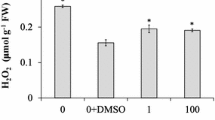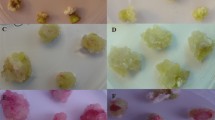Abstract
Vitis vinifera L. cv. Monastrell calli were used to evaluate the effects of long-term exposure to different salicylic acid (SA) concentrations (0.00, 0.01, 0.10 and 1.00 mM) on cell growth and phenolic metabolism. The impaired cell growth caused by high SA concentrations after the first sub-culture of cells was reverted to normal growth even in the presence of 1 mM SA after a few cycles of repeated culture in the same conditions. The initial alterations in the levels of total soluble phenolics, and in the peroxidase (PRX) activity, especially when resveratrol was used as substrate, were also counteracted upon long-term exposure to the phytohormone. Moreover, the recovering of PRX enzymatic activity paralleled the restoration of the PRX isoenzyme pattern. Since phenolic compounds and PRXs can be considered as markers of stress the restoration of their constitutive levels could be considered as indicators of cessation of stress allowing cells to reassume their normal growth and metabolic functions, even in the stressing initial conditions.








Similar content being viewed by others
Abbreviations
- LR:
-
Local resistance
- PRX:
-
Class III plant peroxidase
- ROS:
-
Reactive oxygen species
- SA:
-
Salicylic acid
- SAR:
-
Systemic acquired resistance
- TMB:
-
Tetramethylbencidine-HCl
References
Abreu ME, Munné-Bosch S (2009) Salicylic acid deficiency in NahG transgenic lines and sid2 mutants increases seed yield in the annual plant Arabidopsis thaliana. J Exp Bot 60:1261–1271
Almagro L, Gómez Ros LV, Belchi-Navarro S, Bru R, Ros Barceló A, Pedreño MA (2009) Class III peroxidases in plant defence reactions. J Exp Bot 60:377–390
Bae EK, Lee H, Lee JS, Noh EW, Jo J (2006) Molecular cloning of a peroxidase gene from poplar and its expression in response to stress. Tree Physiol 26:1405–1412
Baxter A, Mittler R, Suzuki N (2014) ROS as key players in plant stress signalling. J Exp Bot 65:1229–1240
Bowler C, Yamagata H, Neuhaus G, Chua NH (1994) Phytochrome signal transduction pathways are regulated by reciprocal control mechanisms. Genes Dev 8:2188–2202
Bulgakov VP, Tchernoded GK, Mischenko NP, Khodakovskaya MV, Glazunov VP, Radchenko SV, Zvereva EV, Fedoreyev SA, Zhuravlev YN (2002) Effect of salicylic acid, methyl jasmonate, ethephon and cantharidin on anthraquinone production by Rubia cordifolia callus cultures transformed with the rolB and rolC genes. J Biotechnol 97:213–221
Calderón AA, Zapata JM, Pedreño MA, Muñoz R, Ros-Barceló A (1992) Levels of 4-hydroxystilbene-oxidizing isoperoxidases related to constitutive resistance in in vitro cultured grapevine. Plant Cell Tissue Organ Cult 29:63–70
Calderón AA, Zapata JM, Muñoz R, Pedreño MA, Ros-Barceló A (1993) Resveratrol production as a part of the hypersensitive-like response of grapevine cells to an elicitor from Trichoderma viride. N Phytol 124:455–463
Calderón AA, Zapata JM, Ros-Barceló A (1994) Peroxidase-mediated formation of resveratrol oxidation products during the hypersensitive-like reaction of grapevine cells to an elicitor from Trichoderma viride. Physiol Mol Plant Pathol 44:289–299
Cao H, Glazebrook J, Clarke JD, Volko S, Dong X (1997) The Arabidopsis NPR1 gene that controls systemic acquired resistance encodes a novel protein containing ankyrin repeats. Cell 88:57–63
Chandra S, Cessna SG, Yahraus T, Devine R, Low PS (2000) Homologous and heterologous desensitization and synergy in pathways leading to the soybean oxidative burst. Planta 211:736–742
Chen JY, Wen PF, Kong WF, Pan QH, Zhan JC, Li JM, Wan SB, Huang WD (2006) Effect of salicylic acid on phenylpropanoids and phenylalanine ammonia-lyase in harvested grape berries. Postharvest Biol Technol 40:64–72
Conrath U, Pieterse CMJ, Mauch-Mani B (2002) Priming in plant-pathogen interactions. Trends Plant Sci 7:210–216
Conrath U, Beckers GJM, Flors V, García-Agustín P, Jakab G, Mauch F, Newman MA, Pieterse CMJ, Poinssot B, Pozo MJ, Pugin A, Schaffrath U, Ton J, Wendehenne D, Zimmerli L, Mauch-Mani B (2006) Priming: getting ready for battle. Mol Plant Microbe Interact 19:1062–1071
DeFraia CT, Zhang X, Mou Z (2010) Elongator subunit 2 is an accelerator of immune responses in Arabidopsis thaliana. Plant J 64:511–523
Delaunois B, Farace G, Jeandet P, Clément C, Baillieul F, Dorey S, Cordelier S (2014) Elicitors as alternative strategy to pesticides in grapevine? Current knowledge on their mode of action from controlled conditions to vineyard. Environ Sci Pollut Res Int 21:4837–4846
Fang F, Huang WD (2013) Salicylic acid modulated flavonol biosynthesis in three key phases during grape berry development. Eur Food Res Technol 237:441–448
Fernandes CF, Moraes VCP, Vasconcelos IM, Silveira JAG, Oliveira JTA (2006) Induction of an anionic peroxidase in cowpea leaves by exogenous salicylic acid. J Plant Physiol 163:1040–1048
Ferrer MA, Ros-Barceló A (1994) Inactivation of cell wall acidic peroxidase isoenzymes during the oxidation of coniferyl alcohol in Lupinus. Phytochemistry 36:1161–1163
Ferrer MA, Calderón AA, Muñoz R, Ros-Barceló A (1990) 4-Methoxy-α-naphthol as a specific substrate for kinetic, zymographic and cytochemical studies on plant peroxidase activities. Phytochem Anal 1:63–69
Ferreres F, Figueiredo R, Bettencourt S, Carqueijeiro I, Oliveira J, Gil-Izquierdo A, Pereira DM, Valentão P, Andrade PB, Duarte P, Ros-Barceló A, Sottomayor M (2011) Identification of phenolic compounds in isolated vacuoles of the medicinal plant Catharanthus roseus and their interaction with vacuolar class III peroxidase: an H2O2 affair? J Exp Bot 62:2841–2854
Franke R, Fry SC, Kauss H (1998) Low-molecular-weight precursors for defense-related cell wall hydroxycinnamoyl esters in elicited parsley suspension cultures. Plant Cell Rep 17:379–383
Fry SC (2004) Primary cell wall metabolism: tracking the careers of wall polymers in living plant cells. N Phytol 161:641–675
Fujita M, Fujita Y, Noutoshi Y, Takahashi F, Narusaka Y, Yamaguchi-Shinozaki K, Shinozaki K (2006) Crosstalk between abiotic and biotic stress responses: a current view from the points of convergence in the stress signaling networks. Curr Opin Plant Biol 9:436–442
Ganesan V, Thomas G (2001) Salicylic acid response in rice: influence of salicylic acid on H2O2 accumulation and oxidative stress. Plant Sci 160:1095–1106
Harfouche AL, Rugini E, Mencarelli F, Botondi R, Muleo R (2008) Salicylic acid induces H2O2 production and endochitinase gene expression but not ethylene biosynthesis in Castanea sativa in vitro model system. J Plant Physiol 165:734–744
Hayat Q, Hayat S, Irfan M, Ahmad A (2010) Effect of exogenous salicylic acid under changing environment: a review. Environ Exp Bot 68:14–25
Hiraga S, Ito H, Yamakawa H, Ohtsubo N, Seo S, Mitsuhara I, Matsui H, Honma M, Ohashi Y (2000) An HR-induced tobacco peroxidase gene is responsive to spermine, but not to salicylate, methyl jasmonate, and ethephon. Mol Plant Microbe Interact 13:210–216
Imberty A, Goldberg R, Catesson AM (1984) Tetramethylbenzidine and p-phenylenediamine-pyrocatechol for peroxidase histochemistry and biochemistry: two new, non-carcinogenic chromogens for investigating lignification process. Plant Sci Lett 35:103–108
Kawano T (2003) Roles of the reactive oxygen species-generating peroxidase reactions in plant defense and growth induction. Plant Cell Rep 21:829–837
Kawano T, Muto S (2000) Mechanism of peroxidase actions for salicylic acid-induced generation of active oxygen species and an increase in cytosolic calcium in tobacco cell suspension culture. J Exp Bot 51:685–693
Kawano T, Kawano N, Lapeyrie F (2002) A fungal auxin antagonist, hypaphorine prevents the indole-3-acetic acid-dependent irreversible inactivation of horseradish peroxidase: inhibition of Compound III-mediated formation of P-670. Biochem Biophys Res Commun 294:553–559
Kovácik J, Grúz J, Backor M, Strnad M, Repcák M (2009) Salicylic acid-induced changes to growth and phenolic metabolism in Matricaria chamomilla plants. Plant Cell Rep 28:135–143
Kraeva E, Andary C, Carbonneau A, Deloire A (1998) Salicylic acid treatment of grape berries retards ripening. Vitis 37:143–144
López-Arnaldos T, Ferrer MA, Muñoz R, Calderón AA (2001) Purification and stability of a basic peroxidase from strawberry callus culture. Plant Physiol Biochem 39:479–486
López-Orenes A, Martínez-Moreno JM, Calderón AA, Ferrer MA (2013a) Changes in phenolic metabolism in salicylic acid-treated shoots of Cistus heterophyllus. Plant Cell Tissue Organ Cult 113:417–427
López-Orenes A, Ros-Marín AF, Ferrer MA, Calderón AA (2013b) Antioxidant capacity as a marker for assessing the in vitro performance of the endangered Cistus heterophyllus. Sci World J 2013. doi:10.1155/2013/176295
Nelissen H, De Groeve S, Fleury D, Neyt P, Bruno L, Bitonti MB, Vandenbussche F, Van der Straeten D, Yamaguchi T, Tsukaya H, Witters E, De Jaeger G, Houben A, Van Lijsebettens M (2010) Plant Elongator regulates auxin-related genes during RNA polymerase II transcription elongation. Proc Natl Acad Sci USA 107:1678–1683
Obinata N, Yamakawa T, Takamiya M, Tanaka N, Ishimaru K, Kodama T (2003) Effects of salicylic acid on the production of procyanidin and anthocyanin in cultured grape cells. Plant Biotechnol 20:105–111
Passardi F, Cosio C, Penel C, Dunand C (2005) Peroxidases have more functions than a Swiss army knife. Plant Cell Rep 24:255–265
Pastor V, Luna E, Mauch-Mani B, Ton J, Flors V (2013) Primed plants do not forget. Environ Exp Bot 94:46–56
Pérez-Tortosa V, López-Orenes A, Martínez-Pérez A, Ferrer MA, Calderón AA (2012) Antioxidant activity and rosmarinic acid changes in salicylic acid-treated Thymus membranaceus shoots. Food Chem 130:362–369
Poór P, Gémes K, Horváth F, Szepesi A, Simon ML, Tari I (2011) Salicylic acid treatment via the rooting medium interferes with stomatal response, CO2 fixation rate and carbohydrate metabolism in tomato, and decreases harmful effects of subsequent salt stress. Plant Biol 13:105–114
Ram M, Prasad KV, Singh SK, Hada BS, Kumar S (2013) Influence of salicylic acid and methyl jasmonate elicitation on anthocyanin production in callus cultures of Rosa hybrida L. Plant Cell Tissue Organ Cult 113:459–467
Rao MV, Paliyath G, Ormrod DP, Murr DP, Watkins CB (1997) lnfluence of salicylic acid on H2O2 production, oxidative stress and H2O2-metabolizing enzymes: salicylic acid-mediated oxidative damage requires H2O2. Plant Physiol 115:137–149
Renault AS, Deloire A, Bierne J (1996) Pathogenesis-related proteins in grapevines induced by salicylic acid and Botrytis cinerea. Vitis 35:49–52
Rivas-San Vicente M, Plasencia J (2011) Salicylic acid beyond defence: its role in plant growth and development. J Exp Bot 62:3321–3338
Ros-Barceló A, Zapata JM, Calderón AA (1996) A basic peroxidase isoenzyme, marker of resistance against Plasmopara viticola in grapevines, is induced by an elicitor from Trichoderma viride in susceptible grapevines. J Phytophatol 144:309–313
Srinivasan T, Kumar KRR, Meur G, Kirti PB (2009) Heterologous expression of Arabidopsis NPR1 (AtNPR1) enhances oxidative stress tolerance in transgenic tobacco plants. Biotechnol Lett 31:1343–1351
Sudha G, Ravishankar GA (2003) Elicitation of anthocyanin production in callus cultures of Daucus carota and the involvement of methyl jasmonate and salicylic acid. Acta Physiol Plant 25:249–256
Suzuki N, Miller G, Morales J, Shulaev V, Torres MA, Mittler R (2011) Respiratory burst oxidases: the engines of ROS signaling. Curr Opin Plant Biol 14:691–699
Takahama U (2004) Oxidation of vacuolar and apoplastic phenolic substrates by peroxidase: physiological significance of the oxidation reactions. Phytochem Rev 3:207–219
Vlot AC, Dempsey DA, Klessig DF (2009) Salicylic acid, a multifaceted hormone to combat disease. Annu Rev Phytopathol 47:177–206
Vogt T (2010) Phenylpropanoid biosynthesis. Mol Plant 3:2–20
Xu E, Brosché M (2014) Salicylic acid signaling inhibits apoplastic reactive oxygen species signaling. BMC Plant Biol 14:155
Yoshioka H, Sugie K, Park HJ, Maeda H, Tsuda N, Kawakita K, Doke N (2001) Induction of plant gp91 phox homolog by fungal cell wall, arachidonic acid, and salicylic acid in potato. Mol Plant Microbe Interact 14:725–736
Zhou X, Hua D, Chen Z, Zhou Z, Gong Z (2009) Elongator mediates ABA responses, oxidative stress resistance and anthocyanin biosynthesis in Arabidopsis. Plant J 60:79–90
Acknowledgments
This work was supported by Fundación Séneca (Project No. 08799/PI/08). AL-O holds a grant from the MECD (AP2012-2559). Part of this work was carried out at the Instituto de Biotecnología Vegetal (Universidad Politécnica de Cartagena).
Author information
Authors and Affiliations
Corresponding author
Rights and permissions
About this article
Cite this article
Lajara, M.M., López-Orenes, A., Ferrer, M.A. et al. Long-term exposure treatments revert the initial SA-induced alterations of phenolic metabolism in grapevine cell cultures. Plant Cell Tiss Organ Cult 122, 665–673 (2015). https://doi.org/10.1007/s11240-015-0800-9
Received:
Accepted:
Published:
Issue Date:
DOI: https://doi.org/10.1007/s11240-015-0800-9




